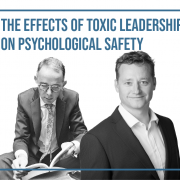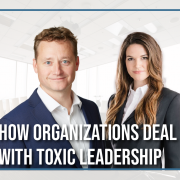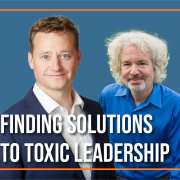Fireside Chat Ep 4: Why Toxic Leadership is Tolerated By Organizations & More W/ Lynn Harrison
Watch the interview here:
Stephan:Â
Hi, my name is Stephan Weidner and I’m the CEO of numi.com. We are all about unleashing the collective potential of organizations, hopefully, your organization. I have a very special guest here with me today, Lynn Harrison, and what we’re going to be talking about is toxic leadership or abrasive leaders.Â
Stephan:Â
What I love is that Lynn brings a couple of specific things to the table. Number one, you’re a master certified coach. In other words, you’ve got the chops, you’ve done this work. She’s worked with many abrasive leaders.Â
Stephan:Â
And secondly, you stay abreast of the science and the evidence. In fact, that’s why I first reached out to you recently here, because you contributed to this book Innovations in Leadership Coaching and the chapter you wrote, that Lynn wrote, was specifically about abrasive leaders.Â
Stephan:Â
Lynn, thank you so much. I really appreciate your time and your willingness to participate with me here today. Thanks. Welcome.Â
Lynn:Â
Thank you. My pleasure.Â
Stephan:Â
Now let’s jump right into the idea of toxic leaders and their place within organizations. We’ve had a number of organizations approach us and say, “We’ve got this leader, they’re causing disruptions, their team is underperforming, individuals are feeling like they’re walking on eggshells.” Then we ask them, “Well, how long has this been going on?” And sometimes the answer is, “Years,” sadly.Â
Stephan:Â
It’s easy to point the finger and say, “Okay, that person’s the problem. They’re the bad apple in the barrel.” But come on. How can an organization allow that to happen for years and years and years? That’s my first question for you, Lynn.Â
Lynn:Â
Yeah, that’s a great question. And that’s certainly been my experience. When I studied abrasive leaders, I was curious about what causes this in the first place. Is it just a problem of a dysfunctional leader with this bad personality that never should have been put in a managerial role in the first place? Or is there something else going on around the leader that’s contributing to the situation? What I found, as you saw in the chapter I wrote called Perfect Storm, it is a confluence of both those factors, so partly about the personality, partly about what’s going on in the organizational system.Â
Lynn:
The leaders I interviewed for my research, were first to admit that they were intense and driven and could get cranky and demanding and so on, that was part of their makeup. But that was exacerbated often in the environment that they found themselves in, so the system they were in had in some ways supportive that behaviour. Sometimes it was a case of just turning a blind eye to this dysfunctional leadership behaviour because most of these people deliver great results. They’re often technically brilliant and because they work hard and they’re very task-oriented, they make things happen and they often make their companies a lot of money. So organizations are fearful to let them go and think even if they bring this issue forward, that could result in this person leaving. Sometimes, not only is that dollars walking out the door, but also specialized competence that other organizations, their competitors would really like to have. That causes some concern for them.Â
Lynn:Â
Now what’s also interesting as well, these leaders cause all kinds of distress in their own work environment, among their coworkers, really disrupting the organization and causing a lot of fear and discomfort and so on. They’re often beloved by their clients. They really come through for clients and they are all about quality results, so the clients often don’t want them to go anywhere. Then of course, there are the senior leaders who are looking at the bottom line and what this person contributes in that respect.Â
Lynn:Â
Sometimes this goes on for years in part because they have protected the organization, they have a boss who makes excuses for them and doesn’t do anything about it. And people keep working around this leader and talk about this leader and what a problem they are, but nobody does anything because the boss is protecting this person because of their ability to deliver.Â
Lynn:Â
The other thing that can be interesting is sometimes an abrasive leader is hired by an abrasive leader, so they don’t see the problem. They just think a lot of people have thin skin and they shouldn’t be so concerned about this behaviour, just get on with your work.Â
Lynn:Â
Or the boss could be someone who’s conflict-avoidant, and doesn’t want to have the difficult conversation with this individual, has avoided it for all this time. And in fact, at some level, might that this leader’s willing to go out and deliver the tough messages to people that their boss doesn’t want to have to do.Â
Stephan:Â
Mm-hmm (affirmative).Â
Lynn:Â
So there’s a whole bunch of different factors that can be going on in the background.Â
Stephan:Â
Yeah, there’s a number there. I just want to get a sort of a list. You mentioned the boss or the supervisor of that individual is conflict-avoidant or they’re also abrasive in their own nature. That’s a factor.
Stephan:Â
The second is you mentioned that the organization is making a lot of money thanks to this individual and the customers are really happy. Happy customers and revenue, that’s probably going to exacerbate the problem. And what else?Â
Lynn:Â
Well, the thing I found in my research over and over again was that these managers were promoted into managerial roles because they were uber individual contributors, not because they know how to lead. So the organization is choosing people who deliver good results, the person’s thinking, “Oh great, I make more money. I don’t really know what it means to manage people, but I’ll keep doing what I’ve been doing that’s made me successful.” Only now they’re in a role where they have to get things done and feel through and with people and they don’t know-how.Â
Lynn:Â
So they haven’t necessarily been oriented to what it means to lead. They haven’t been trained to do that. They were great engineers, IT experts, lawyers, financial analysts. They maybe were trained in some other area and now all of a sudden they’re leading people without any understanding of how to do that.Â
Lynn:Â
The other thing I found is that these organizations were, as you’ve mentioned, really focused on goals, a very task-oriented kind of culture. So even though they might say, “People are our most important asset,” when push comes to shove, they’re more interested in the results and keeping their shareholders happy than figuring out how that person actually delivered results and holding them accountable around the “how.” So that’s another common thing I found in these organizations.Â
Lynn:Â
They are also typically in a very competitive environment, inside and out. The leaders vied with each other for influence or resources and the pecking order inside, but they were also often in a competitive industry where it was pretty much this idea of dog eat dog and only the strongest survive an aggressive cultural milieu.Â
Lynn:Â
The lack of honest and direct feedback was very typical. These people had gone along for years and often when I’d start to do coaching with them and they got their first 360, they were just devastated to find out how poorly people thought of them and that people actually feared them, maybe hated them, avoided them in the hallway. They usually knew that they were pretty tough and that they could be pretty demanding of people, but they did not get the extent to which they actually caused that much distress. Those people went home at the end of the week wondering if they wanted to come back the next week or talking about their latest experience with this leader to their spouse all weekend. They really did not, for the most part, get that.Â
Stephan:Â
I think that’s an interesting point you make there Lynn because we’ve seen that with organizations where we ask them, “Hey, have you approached this individual? Do they know what the potential consequences are here?” For the most part, we hear back a response, “Well, if they can’t see the signs, then they deserve to go,” kind of thing. In other words, no one’s giving them the feedback that, “Hey, you’re causing disruption here. Did you realize that people are stressed out, avoiding you, et cetera?” For those around that leader, I think it’s so obvious. For that leader, they’re blind to it. What’s up with that? How is it possible that a leader is so blind to the impact they’re having on the people around them?
Lynn:Â
Yeah. It raises the complexity of the issue because, on the one hand, a lot of these leaders are not assessing their success based on their relationships with people. They’re so task-oriented, they’re looking at, “Did we get the job done?” So it’s not really crossing their mind that in the process, they not only didn’t make friends, they lost a lot and they’re not even sure why that matters. I don’t think we can assume that every abrasive leader really wants to be liked and that’s a super important value to them. Might be to me as a coach, but that’s not necessarily their value.Â
Lynn:Â
What’s been interesting to find with some of these leaders, what motivated them to change, it wasn’t this awareness that people didn’t them so much as their behaviour was interfering with the ability to get good results. It shut people down or distracted people from doing the job. People didn’t want to raise a different point of view in front of them. So the quality of the thinking was affected and therefore the output. They didn’t actually shift their value system to being a person who wants to be warm and fuzzy, but they became aware that they were causing way more disruption and distraction in the workplace than they realized.Â
Stephan:Â
And do they, in your experience, always equate that disruption with lower quality of work or is there some education that needs to go on there?Â
Lynn:Â
Well, I think there’s some education, but at some level, they know because often what they come in with is, “I have to work harder than anybody else around here.” Or I go into a meeting and I ask people for their opinions and nobody says anything, so there’s some evidence that’s there that they’re not quite picking upon. And they concluded, they almost see themselves as heroes that are busting their butt for the organization, and what’s with these other people? So as much as they’re really smart in certain ways, they don’t always read the greens very well. Dr. Crawshaw has described as they’re missing that emotional sonar to pick up the cues sometimes about just how much people are pulling back the harder they push.Â
Lynn:
What I found really interesting was sometimes these people had conflicting views about losing their cool with people. They thought, on the one hand, “Maybe that’s what you need to get people to get moving,” because they’re not skilled leaders. “So maybe if I bark at them, that’ll get some action.” Or, “I had every right to get mad at them because they did drop the ball. They didn’t get it in on time or the quality Â
wasn’t what it should’ve been.”Â
Lynn:Â
They have this cognition going on. And then at the same time, they’ll often say to themselves, “Well gosh, that didn’t go very well.” Because once they’ve calmed down and they’re not as emotionally triggered, the thinking part of their brain, frontal lobes kick in and they go, “I’m not sure that I handled that the best possible way.”Â
Lynn:Â
But the part of their EQ, the emotional regulation part, is often an area that needs work, so when they start to get triggered, when someone makes a mistake or something happens before they know it, it’s spiralled out and then they’ve lost it and said things that were hurtful.Â
Lynn:Â
And this brings us back to the whole sort of organizational environment. Typically there’s a lot of stress, so these leaders are already stressed and feeling pressured, and when something goes wrong and they aren’t able to calm themselves down sufficiently before they throw the pan or they smashed their fist down on the table, or they say something that’s going to be disrespectful or hurtful to other people.Â
Stephan:Â
Thinking about the organization now, and they’re often coming to us, as I mentioned because they have this problem and we recognize, acknowledge that there are systemic issues that are exacerbating the issue. What does an organization need to do before getting coaching for this individual? Because it seems a little too simplistic to just say, “Okay, well, let’s coach this individual and they’re going to improve their behaviours.”Â
Lynn:Â
Yeah.Â
Stephan:Â
Is there a checklist? What should the organization be thinking about prior to getting that coaching?Â
Lynn:Â
Well, I think the first thing they have to decide is whether they want to keep this person, they honestly want to keep this person. Sometimes I’ll just draw a little quadrant model and I’ll say, “So if the vertical axis is the degree to which this person delivers results, so 10 is they’re amazing and zero they’re out so good, if that person’s not in the upper part of that scale in terms of their ability to deliver results, and Â
then you look at the horizontal scale which is their conduct, if their conduct is also on a scale of one to 10 in the lower half of that scale, then you’ve got somebody you probably should be considering exiting because they’re not really strong in either of those.” That’s one thing to think about in the first place before you decide whether you’re even going to think about some intervention.
Stephan:Â
Before you go onto the next point, I want to just make that distinction and really highlight it because I think making that distinction between performance and conduct is really important. I think a lot of individuals within organizations, whether they’re abrasive or not, will smush those two things together. They don’t realize that they’re actually separate, right? You can be high performing and have great conduct. You can have poor conduct and, and be a high performer as well. I like that. I appreciate that distinction. Thank you.Â
Lynn:Â
Yeah. I would say that your regular coaching, executive coaching, is the person who is in the upper quadrant in terms of their ability to deliver results and performance, but they’re also high in terms of conduct. So that’s a regular coaching engagement.Â
Lynn:Â
An abrasive leadership coaching engagement is specialized because it is for that person who is in that upper left-hand quadrant, producing results but not so great on conduct. The other thing I’d invite an organization to think about is, “What’s your timeline?” If this has been going on for quite a long time, is there too much water under the bridge? Will people actually trust this person again, even if they really try to change? Or is it just too far gone, there have been things said that are really quite egregious and people don’t want to work with them anymore.Â
Lynn:Â
Or, do you have the funds and the time to commit? Because before you intervene, you want to make sure that you actually can do a proper job of trying to bring this person back into line with what you’re looking for from your leaders. It’s not going to be a 360 and three-session debrief kind of a deal. It’s going to take some time and commitment.Â
Stephan:Â
That part about knowing whether or not the organization can support this individual through their change, I think that’s a good question. What we find is often the person we’re talking with, we’re communicating with, is a leader and they really see the positive sides of this abrasive leader. They don’t necessarily experience the impact personally one-on-one. And so how does that type of individual assess whether or not is there too much water has passed underneath the bridge?Â
Lynn:Â
Yeah, that’s a really good point. Very often, these individuals manage up quite well. And so not only are they beloved by clients, but also senior management or the board may think very highly of them. So their behaviour with them is usually more controlled and more planful, and then they lose it with their coworkers, their peers or their direct reports when the pressure gets to them and nobody’s really looking.Â
Lynn:Â
By the way, I think it’s important to emphasize we’re talking about a pattern of behaviour, not the occasional outburst. I think lots of us can say we were not at our best at certain times under pressure, but this is an ongoing issue.
Lynn:Â
Typically or very often, the complaints go to the HR department, the human resources leader, not the boss of the toxic leader. Then human resources will bring this to the attention of the leader’s boss. One of the things that’s really important is that the leader’s boss actually buys that there is a problem and is willing to support, not just bringing in someone from the outside to work with this leader, but actually to be a good internal leader who’s willing to have the initial conversation with this abrasive leader, even if he or she hasn’t experienced the behaviour themselves. And to draw that line in the sand, that the behaviour cannot continue. As much as they value what this person brings to the organization, they cannot in good conscience allow them to continue acting that way with staff. It’s just too incongruent with the values of the organization and that has to be really clear. As is that we want to help you.Â
Lynn:Â
Nobody wants to be sent to coaching with a gun to their head. That’s not likely to be very successful. So that boss, the boss of the abrasive leaders, the conversation is really important in setting up the intention of this, the support that will be given.Â
Lynn:Â
And also hope. I’ve had abrasive leaders come to me and say, “I don’t know if I can do this. I don’t know if I can change. I’ve been acting this way for a long time and it seems daunting. I’m really not sure where to start.” The thing to remember is this coaching isn’t just vertical development. It has to be partly that, where they’re looking at their identity and their worldviews and their mental models of leadership, all that sort of deeper stuff. Also to help them get started, they have to get through just the shock of, “Oh my gosh, this is how people see me?” Which can bring up a lot of shame, even anger, “Why didn’t they tell me? This has been going on this long.” They need to get through that.Â
Lynn:Â
They also need to get some simple tools around, “What do I do when I get triggered? How do I have a conversation that doesn’t leave a person feeling demeaned, but we still talk about what needs to happen? How do I calm myself down when I’m noticing I’m getting stressed? How do I get back in touch with what is actually going on in my body that gives me signals I’m starting to get hooked and stressed?” Because a lot of these individuals have lost that connection with the body, they’re “doing machines” and strong thinkers.Â
Stephan:Â
For you as the coach, what do you require, then, from the organization? Because of course, you want to be set up for success, right? Even if they paid you gobs of money, I suspect there will be conditions under which you’re just not going to work because you want to produce results and you want to be able to support that leader in making behaviour change.Â
Stephan:Â
What are some of those specific requirements that you have for engagements that you take on?Â
Lynn:Â
Yeah, you’re bringing up a really important point. Both individual and organizational readiness is key. In terms of the organization, as I mentioned, the boss has to be all in. This can’t just be something delegated to an external coach and she or he washes their hands of this, the problem. Not only the initial conversation but providing ongoing feedback to this individual, participating in alignment conversations from time to time with the coach, they need to be willing to do a 360, so collecting multi-rater feedback from the organization. Again, that takes some time, it takes some energy and there’s usually some cost. I use both narrative 360 and I use the leadership circle, so there’s the investment in doing something comprehensive.Â
Lynn:Â
There needs to be a sincere desire for the organization to give this individual a chance. If it’s just, “We’re going to get rid of them, but before we do, we can say we tried coaching and we’ll give them a few sessions.” That’s not the work I would want to do.Â
Lynn:Â
It’s going to be probably six, eight months, maybe longer. This behaviour may have been going on for 30Â years, so to think it’s going to change in half a dozen sessions isn’t realistic.Â
Lynn:Â
There needs to be clear contracting up front, so there’s that understanding that the coach and the coachee relationship is confidential. Even though there’s a 360 and all this information, that is only going to be shared with the abrasive leader receiving coaching. And then I work with that leader to take that back to the people who gave the feedback.Â
Lynn:Â
There may be some mea culpa that’s needed, but also people want to know what it is that the leader got out of this. What are they working on? And quite frankly on the mea culpa side, even the organization may need to do a mea culpa, like “We should have given you this feedback a long time ago and we now want to do it differently. And we want to support you in getting there.”Â
Lynn:Â
Then the other part about the person’s readiness, they can’t just be giving lip service to this, “Okay, if that’ll get you off my back, I’ll do coaching.” They do have to really want to change and put their skin in the game. It’s not an easy thing often because I find these leaders are not necessarily people that are used to opening up about their feelings and what’s going on really inside of them, that’s causing them to get stressed and then take it out on other people, or what’s really driving them. This may be really new territory for them. The willingness to have that courage to open up to somebody and start to understand their behaviour and start to experiment with new ways of being with other people takes a lot of commitment.Â
Stephan:Â
Yeah. Are there ever cases, have you come across cases where the readiness appeared to be there, at least they’re giving it lip service, but then ultimately it wasn’t there and you have to either pull out or stop the engagement. Does that happen?Â
Lynn:
Yeah, sometimes I think people don’t realize how hard it will actually be for them. And if these are very task-oriented, driven, busy people, now to carve time out to be reflective about their behaviour, to sit down and talk to somebody about what’s going on in them, that can be a really foreign thing. So they can get pulled back into their busyness right. If we’re talking about a system, systems tend to want to return to homeostasis, whatever’s familiar. Breaking that pattern may not happen really easily. That’s why they need a strong coach who’s not only compassionate and willing to work with this person and not see them as evil and disordered and not worthy of help, but someone who cares and cares enough to say, “Hey, we’ve got to talk about what’s going on here.” If they start showing up late for calls or they cancel at the last minute, or they haven’t done what they said they’d do in-between the coaching sessions, these are all signals that an experienced coach would know where signs that things are getting off the rails.Â
Lynn:Â
Also, the coach has to do their own inner work because to be able to be there with someone and create a safe container in which they can do this work, but still be challenging and strong in a good way, because these are smart people and they’re quick. The coach has to be on his or her game to work with them.Â
Stephan:Â
A hundred percent. Lynn, any final thoughts for an organization that is dealing with an abrasive leader? Any last comments that we didn’t cover?Â
Lynn:Â
The main thing that comes to mind for me is just, don’t delay dealing with this situation. You basically will eventually have to step back and go, “How did we get here? What’s missing in our system? Are we rewarding the wrong behaviour? Or are we rewarding just results and not how people get results? Are we not choosing the right folks to be leaders? Are we not preparing them for those roles adequately?” We can do all that sort of review of what do we need to change to avoid this in the future?Â
Lynn:Â
But if we have a situation here and now that for whatever reason is happening, it’s incumbent on us, not just to create a physically safe work environment for our people, but a psychologically safe environment. It’s not only the safety of the people around and their wellbeing at work, so they can go to work and come back feeling good about things every day. But the organization’s own reputation is at stake if they allow this to continue.Â
Lynn:Â
Finally, what I would say is with a lot of these leaders, their own personal wellbeing is at stake. I’ve seen some of these leaders, the reason they act this way is they’re so brittle. They’ve pushed themselves so hard, not taking vacations or not taking care of themselves. As long as this keeps going, that starts to erode the wellbeing even of the abrasive leader.Â
Stephan:Â
Would you say that there’s not just a financial motivation or financial responsibility for the organization to address it, but also a moral one?
Lynn:Â
Yeah, I believe there is. And organizations can have both because if they can help turn around this leader, they salvage this contributor who has all kinds of experience and great skills, and they protect the wellbeing of their culture, the health and productivity and potential that’s just waiting to be tapped into in the organization.Â
Stephan:Â
Well, that’s a perfect note to end on, Lynn. Because that’s what I mentioned right at the beginning. We’re all about unleashing the potential of organizations. So thank you, Lynn. I really appreciate your time and your insights and the great work that you’ve done over the years to assist organizations with abrasive leaders.Â
Lynn:Â
Thanks for inviting me today.










